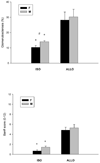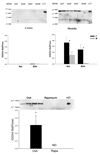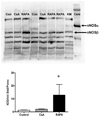Renal cortex neuronal nitric oxide synthase in response to rapamycin in kidney transplantation
- PMID: 17971307
- PMCID: PMC2247710
- DOI: 10.1016/j.niox.2007.10.001
Renal cortex neuronal nitric oxide synthase in response to rapamycin in kidney transplantation
Abstract
Decreased renal neuronal nitric oxide synthase (nNOS) is present in various chronic kidney diseases although there is relative little known in chronic allograft nephropathy (CAN). Female sex increases the risk of acute rejection and calcineurin-inhibitor toxicity but decreases the risk of CAN. Rapamycin (RAPA) is an alternative immunosuppress although there is no information whether it is effective in females. We therefore investigated the efficacy of RAPA in both sexes and the impact of RAPA on renal cortex structure and nNOS expression. Male (M) and female (F) F344 kidneys were transplanted into same sex Lewis (ALLO) or F344 (ISO) recipients and treated with 1.6 mg/kg/day of RAPA for 10 days. Grafts were removed for renal histology and endothelial (e)NOS and neuronal (n)NOS protein measurements at 22 weeks. All ALLO rats survived without acute rejection. ALLO F survived with mild proteinuria and CAN at 22 weeks similar to ALLO M, while ISO F had better outcome than ISO M. Cortical nNOSalpha was undetectable in all RAPA groups; however, nNOSbeta transcript and protein were compensatory increased. Both ALLO and ISO F showed higher medullary nNOSalpha but lower cortical eNOS abundance than M groups. In male ALLO RAPA decreased renal cortical nNOSalpha but increased nNOSbeta expression. This may represent compensatory upregulation of nNOSbeta when nNOSalpha-derived NO is deficient.
Figures





Similar articles
-
Splice variants of neuronal nitric oxide synthase are present in the rat kidney.Nephrol Dial Transplant. 2009 May;24(5):1422-8. doi: 10.1093/ndt/gfn676. Epub 2008 Dec 10. Nephrol Dial Transplant. 2009. PMID: 19073653 Free PMC article.
-
Discoordinate regulation of renal nitric oxide synthase isoforms in ovariectomized mRen2. Lewis rats.Am J Physiol Regul Integr Comp Physiol. 2007 Feb;292(2):R819-26. doi: 10.1152/ajpregu.00389.2006. Epub 2006 Oct 5. Am J Physiol Regul Integr Comp Physiol. 2007. PMID: 17023669
-
Sex differences in response to cyclosporine immunosuppression in experimental kidney transplantation.Clin Exp Pharmacol Physiol. 2008 May;35(5-6):574-9. doi: 10.1111/j.1440-1681.2007.04841.x. Epub 2007 Dec 7. Clin Exp Pharmacol Physiol. 2008. PMID: 18070141 Free PMC article.
-
Renal nitric oxide production in rat pregnancy: role of constitutive nitric oxide synthases.Am J Physiol Renal Physiol. 2010 Oct;299(4):F830-6. doi: 10.1152/ajprenal.00300.2010. Epub 2010 Jul 14. Am J Physiol Renal Physiol. 2010. PMID: 20630934 Free PMC article.
-
Combination therapy of mycophenolate mofetil and rapamycin in prevention of chronic renal allograft rejection in the rat.Transplantation. 2003 Jan 15;75(1):54-9. doi: 10.1097/00007890-200301150-00010. Transplantation. 2003. PMID: 12544871
Cited by
-
Molecular mechanisms of neuronal nitric oxide synthase in cardiac function and pathophysiology.J Physiol. 2014 Aug 1;592(15):3189-200. doi: 10.1113/jphysiol.2013.270306. Epub 2014 Apr 22. J Physiol. 2014. PMID: 24756636 Free PMC article. Review.
-
Lethal and sublethal effects of a methomyl-based insecticide in Hoplobatrachus rugulosus.J Toxicol Pathol. 2017 Jan;30(1):15-24. doi: 10.1293/tox.2016-0039. Epub 2016 Oct 21. J Toxicol Pathol. 2017. PMID: 28190921 Free PMC article.
-
Protective actions of nebivolol on chronic nitric oxide synthase inhibition-induced hypertension and chronic kidney disease in the rat: a comparison with angiotensin II receptor blockade.Nephrol Dial Transplant. 2012 Mar;27(3):913-20. doi: 10.1093/ndt/gfr449. Epub 2011 Aug 19. Nephrol Dial Transplant. 2012. PMID: 21856762 Free PMC article.
-
Nebivolol does not protect against 5/6 ablation/infarction induced chronic kidney disease in rats - comparison with angiotensin II receptor blockade.Life Sci. 2012 Jul 26;91(1-2):54-63. doi: 10.1016/j.lfs.2012.06.005. Epub 2012 Jun 19. Life Sci. 2012. PMID: 22727796 Free PMC article.
-
Sexual dimorphism in development of kidney damage in aging Fischer-344 rats.Gend Med. 2012 Aug;9(4):219-31. doi: 10.1016/j.genm.2012.06.003. Epub 2012 Jul 20. Gend Med. 2012. PMID: 22819558 Free PMC article.
References
-
- Meier-Kriesche HU, Ojo AO, Leavey SF, Hanson JA, Leichtman AB, Magee JC, Cibrik DM, Kaplan B. Gender differences in the risk for chronic renal allograft failure. Transplantation. 2001;71:429–432. - PubMed
-
- Meier-Kriesche HU, Schold JD, Kaplan B. Long-term renal allograft survival: have we made significant progress or is it time to rethink our analytic and therapeutic strategies. Am. J. Transplant. 2004;4:1289–1295. - PubMed
-
- Neugarten J, Srinivas T, Tellis V, Silbiger S, Greenstein S. The effect of donor gender on renal allograft survival. J. Am. Soc. Nephrol. 1996;7:318–324. - PubMed
-
- DiJoseph JF, Fluhler E, Armstrong J, Sharr M, Sehgal SN. Therapeutic blood levels of sirolimus (rapamycin) in the allografted rat. Transplantation. 1996;62:1109–1112. - PubMed
-
- Ninova D, Covarrubias M, Rea DJ, Park WD, Grande JP, Stegall MD. Acute nephrotoxicity of tacrolimus and sirolimus in renal isografts: differential intragraft expression of transforming growth factor-beta1 and alpha-smooth muscle actin. Transplantation. 2004;78:338–344. - PubMed
Publication types
MeSH terms
Substances
Grants and funding
LinkOut - more resources
Full Text Sources
Medical

